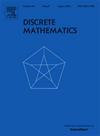哪些拉普拉斯共谱图具有相同的度序列?
IF 0.7
3区 数学
Q2 MATHEMATICS
引用次数: 0
摘要
Liu et al.(2018)[13]提出了“哪些共谱图具有相同度序列?”的问题。本文介绍了一些影响图的拉普拉斯谱半径的图运算,并给出了一种由旧的拉普拉斯协谱图构造拉普拉斯协谱图的新方法。在此基础上,我们证明:设G为连通图,设H为与G的拉普拉斯共谱。如果图G的第二大拉普拉斯特征值小于4,且G和H都不是生成W1的子图,则H必须与G具有相同的度序列,其中W1是本文定义的一个特定图。该结果扩展了Liu et al.(2018)[13]的相应结果。此外,还提供了极值图来说明与W1相关的条件是至关重要的。本文章由计算机程序翻译,如有差异,请以英文原文为准。
Which Laplacian cospectral graphs have the same degree sequences?
Liu et al. (2018) [13] raised the problem: “Which cospectral graphs have the same degree sequences?”. In this paper, we introduce some graph operations affecting the Laplacian spectral radius of a graph, and then provide a new method to construct Laplacian cospectral graphs from old Laplacian cospectral graphs. Based on this, we show that: Let G be a connected graph and let H be Laplacian cospectral with G. If the second largest Laplacian eigenvalue of graph G is less than 4, and G and H are not spanning subgraphs of , then H must have the same degree sequence as G, where is a specific graph defined in the paper. This result extends the corresponding result of Liu et al. (2018) [13]. Besides, extremal graphs are also provided to show that the condition related to is crucial.
求助全文
通过发布文献求助,成功后即可免费获取论文全文。
去求助
来源期刊

Discrete Mathematics
数学-数学
CiteScore
1.50
自引率
12.50%
发文量
424
审稿时长
6 months
期刊介绍:
Discrete Mathematics provides a common forum for significant research in many areas of discrete mathematics and combinatorics. Among the fields covered by Discrete Mathematics are graph and hypergraph theory, enumeration, coding theory, block designs, the combinatorics of partially ordered sets, extremal set theory, matroid theory, algebraic combinatorics, discrete geometry, matrices, and discrete probability theory.
Items in the journal include research articles (Contributions or Notes, depending on length) and survey/expository articles (Perspectives). Efforts are made to process the submission of Notes (short articles) quickly. The Perspectives section features expository articles accessible to a broad audience that cast new light or present unifying points of view on well-known or insufficiently-known topics.
 求助内容:
求助内容: 应助结果提醒方式:
应助结果提醒方式:


